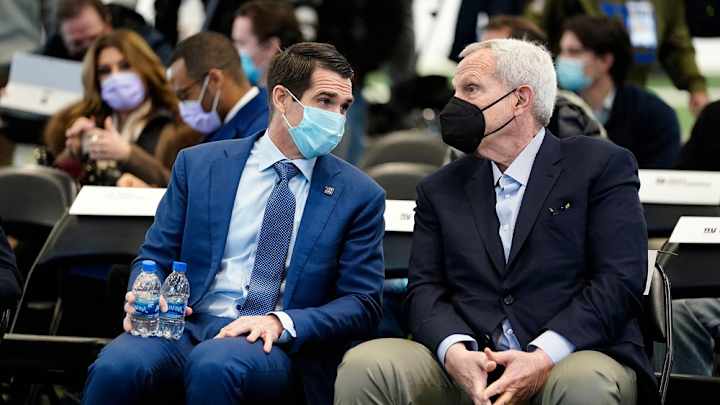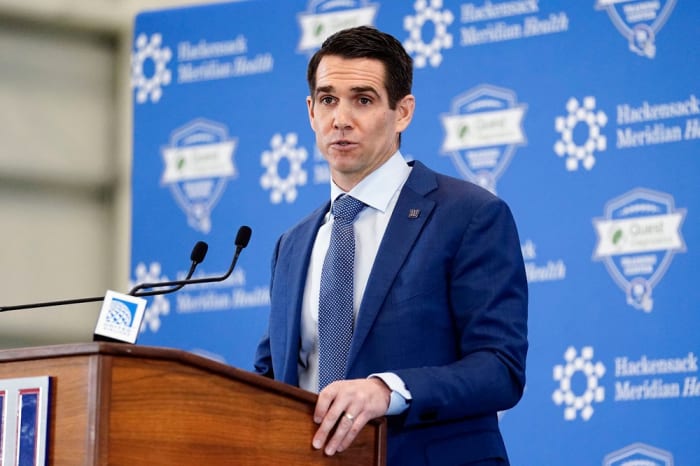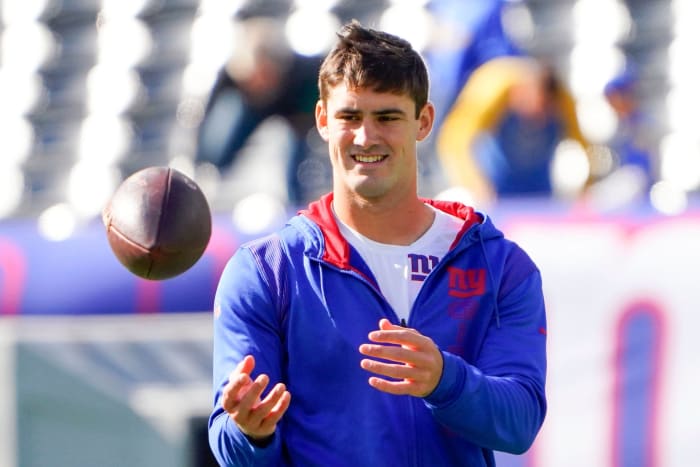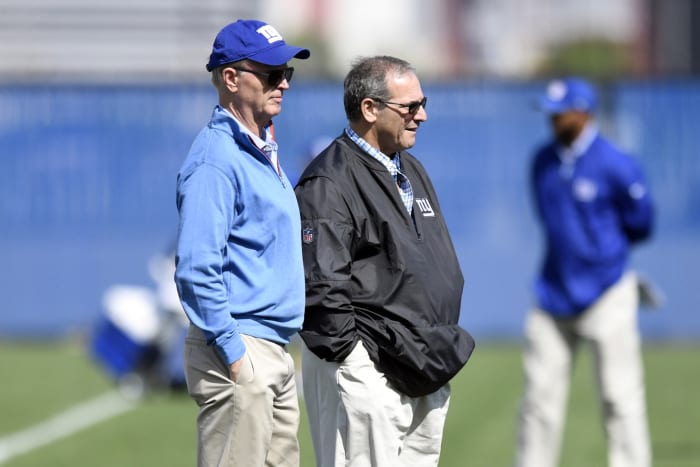How Bills' Salary Cap Management Tactics Differ from Giants' Methods

As Joe Schoen, the Giants' new general manager, settles into his position, there will be loads of work to be done.
High atop of the list will be straightening out the Giants salary cap, which right now is in dire straights regarding space.
That process will commence soon enough if it hasn't already, with Schoen and new head coach Brian Daboll sitting down to watch film on players with big cap numbers that need to be adjusted or lopped off the books to create space.
While Schoen isn't believed to be a cap expert, it looks as though assistant general manager Kevin Abrams will stay on to help stabilize the Giants cap situation--one place where Schoen can find some fiscally sound cap practices is his old team.
Here are a few noticeable differences I was able to find between how Buffalo has set up their salary cap and how the Giants have done things.
Low Average Per Year Cap Hits
Except for quarterback Josh Allen, not a single player has an annual contract average of over $18 million. And only seven of the Bills players under contract have an average annual earning that tops $10 million.
This setup ensures the Bills aren't top-heavy, which they are not. According to data from Spotrac, the Bills' top five cap hits for 2022--none of which a single member counts for more than 8.51 percent of the total cap, account for 35.9 percent of their total cap liabilities.
That's a far cry from the Giants, whose top five cap figures account for 47.1 percent and who have three players--Leonard Williams, Kenny Golladay, and Adoree' Jackson--who each account for at least 10 percent of the team's total cap space.
Tiered Guaranteed Earnings
The Bills did something rather creative when it came to Allen's contract extension that I don't ever recall the Giants doing (but which I suspect they'll look to incorporate in the future when they have to sign players to big-money deals.
They set up a tiered system that their quarterback can "earn" his guaranteed money in future years.
In 2024, Allen is due a $23.5 million base salary that becomes fully guaranteed, but only if he meets specific criteria in 2022 and 2023. Specifically, Allen must be on the roster on March 21 of this year to ensure $10 million of his 2024 base salary is guaranteed. If he is on the roster as of March 21, 2023, the remaining $13.5 million of his 2024 base salary becomes guaranteed.
What this does for the Bills is it gives them an out without having to take a huge cap hit if something unexpected should happen. It also gives the Bills some flexibility to finagle Allen's cap numbers in the interim.
Guaranteed money is very attractive to a player because, as the term suggests, it's guaranteed cash that's coming to them regardless. The problem with guaranteed money comes when a team needs to restructure, it has to ensure that the new restructure covers the original guaranteed amount.
Roster Bonuses
The Bills also made heavy use of roster bonuses, something the Giants haven't used much.
The benefit of using a roster bonus is that it can lessen the signing bonus. Ideally, roster bonuses coincide with all or part of the base salary guaranteed (since the player will be on the roster anyway). But this is not mandatory.
Sixteen Bills players have roster bonuses in 2022 versus only five Giants players this year. A roster bonus is usually paid out either at the start or at some point (usually about five days in) of the new league year. There are also other bonuses, such as reporting bonuses, but the Bills don't appear to be using those.
Game Day Bonuses
Per-game roster bonuses are a great way for a team to protect themselves if a player whose injury status is questionable--unfulfilled per-game roster bonuses get credited back to the salary cap at the end of the year.
They can also help ensure that players who might not be active every week due to the specific game plan don't cost the team extra money to sit on the inactive list.
Besides using a game day bonus on a player coming off an injury, teams can also give a game-day bonus to a player who might be at the bottom of the depth chart at his position and thus not be guaranteed to get a game-day uniform, such as an extra defensive lineman who might be inactive one week if his team is facing a pass-heavy opponent but then be active the following week against an opponent with a strong running game.
The Bills currently have 15 players signed who are eligible for per-game roster bonuses. The Giants only have two players who have per-game roster bonuses, cornerback Adoree' Jackson and offensive lineman Nick Gates. Surprisingly, Kenny Golladay, who was coming off a season-ending hip injury in 2020, did not get a similar mechanism as part of his contract.




The Giants had a plan this off-season to build the roster into a playoff contender. Alas for them, it was a shortcut that came with a lot of risks that now look as though they'll come back to bite the team for the long-term.
Workout Bonuses
The Bills also made heavier usage of workout bonuses, paid out to players who meet a certain percentage of the team's scheduled off-season workout dates. In the past, the threshold for the Giants to pay out the workout bonus was reportedly 90 percent, but it remains to be seen what the criteria will be under the new regime. (It's unknown what the Bills' threshold is.)
Besides getting players into the building where their workouts can be supervised by the strength and conditioning staff, the benefit of a workout bonus is that it's a one-time payout that can help offset some of the signing bonus. It's also easy money for the player to collect for simply agreeing that his job is indeed a year-round event requiring his presence even in the off-season.
Twenty-two Bills players were given a workout bonus, the average of the workout bonuses being $138,068, one of the highest averages in the league.
The Giants, meanwhile, have seven players under contract with workout bonuses, and they average $82,857.
Other Differences
As part of their effort to optimize their salary cap space last year, the Giants used the voidable year mechanism to help thin out the impact of a signing bonus.
This tactic was used for Nate Solder's restructured contract and receiver Kenny Golladay's new deal. While the team financially accomplished what they needed to in the short-term. in the long term, they will carry dead money for a player no longer on their roster. (This year, it will be Solder, who has a $4 million dead money hit, and, assuming he finishes out his Giants contract, Golladay in 2025, when he'll count for $3.4 million in dead money.)
The Bills had a rough go regarding the dead money when Brandon Beane and Joe Schoen first joined the organization. Using figures provided by SPOTRAC, between 2017-2019, the Bills averaged $38,736,094 in dead money. Between 2020-2022, that average has dropped to $7,861,487.
The Giants? From 2018 to 2019 (the first two years of the Dave Gettleman era), they averaged $49,527,139 in dead money. From 2020 to 2022, they've averaged $13,548,453, and they only have $289,206 in dead money so far this year.
All teams will have dead money as a result of roster transactions. But one of the keys to keeping this under control is to make sure the players being brought in legitimately fit what the coaching staff is trying to do.
Join the Giants Country Community
- Sign up for our FREE digest newsletter
- Follow and like us on Facebook
- Submit your questions for our mailbag
- Listen and subscribe to the daily LockedOn Giants podcast.
- Subscribe and like the new LockedOn Giants YouTube Channel
- Sign up for our FREE message board forums
